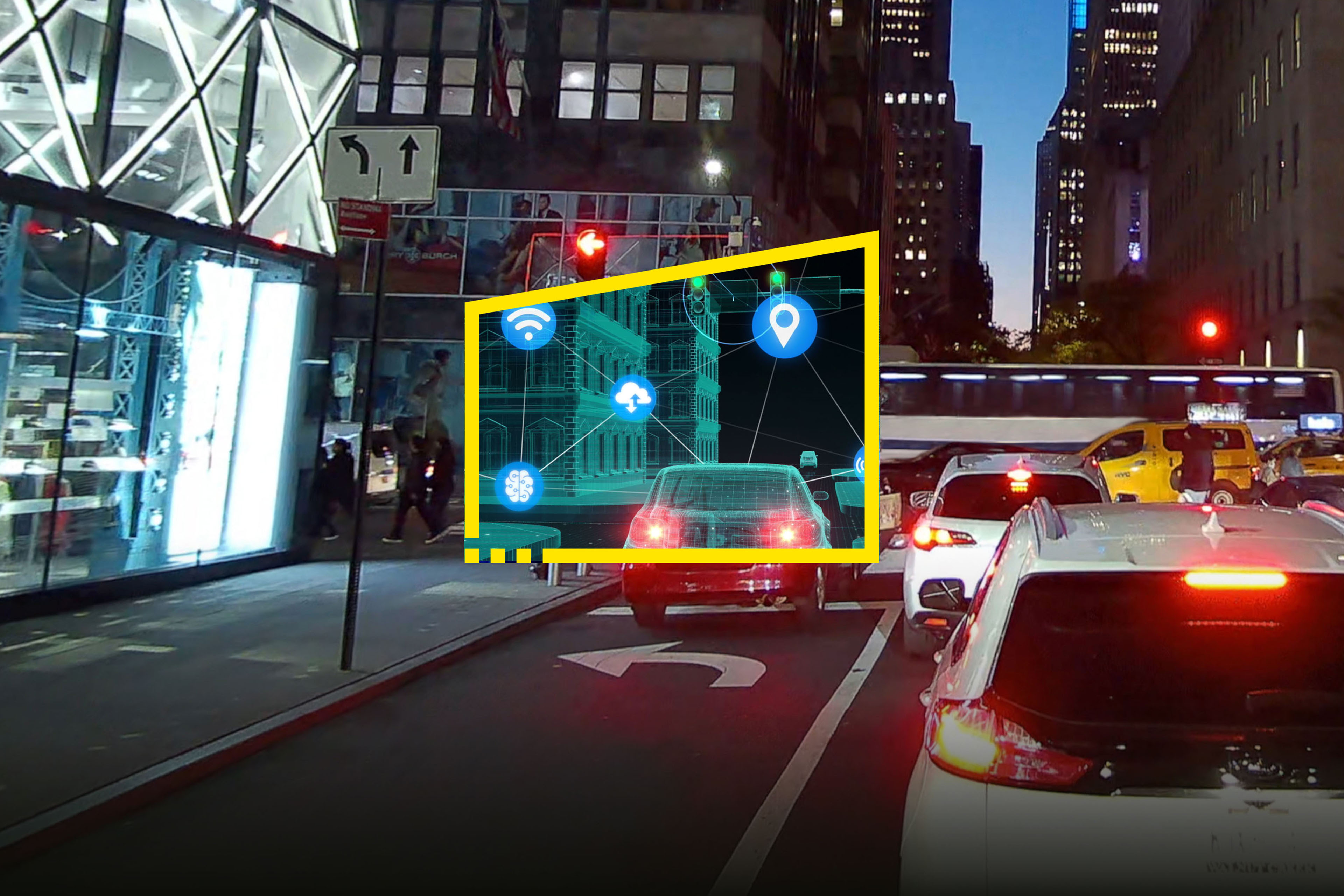In this edition of Tech Horizon, we present a vision of data centricity as an insight engine that unlocks the value of operational, customer and market data. We then present a pragmatic approach to deploying the technology foundation that will support the new data world.
This is happening right now with your peers and competitors – tech-enabled transformations that exceed expectations are forecasting an average annual revenue growth of 5.7% vs. 4.0% for transformations falling short of expectations. Where are you on the strategic journey to the next generation of data and analytics?

Chapter 1
Transforming your tech foundation
Firms must envision a new data-driven operating model and architect a technology foundation that will support it.
The destination: what data centricity will mean to your enterprise
In a few short years, data and analytics will drive and predict the most important decisions, processes and interactions of the enterprise. What will this data centricity mean to the company?
Instead of siloed, restricted sets of facts, a data fabric will be integrated across the enterprise. Data expertise will expand from the IT department into business group, internal operations, and customer relationships. Employees across the entire enterprise will manage, routinely access and use the data necessary to improve their decisions and processes. This is a migration from data management to data centricity.
Mundane tasks will be automated, allowing executives and workers to focus on value. Rather than fall back on hunches and spreadsheets, your enterprise will be empowered to query, correlate and analyze in real time. Customer feedback will be instantaneous and highly accurate.
Setting the foundation
| Current state | Data centricity |
| Siloed, disparate data |
Data fabrics integrating data |
| IT as the data experts |
Users as domain data experts |
| Isolated devices or machines |
Connected IoT devices |
| Data-driven decisions at the center |
Decisions closer to the customer |
| Sporadic customer feedback |
Integrated and real-time data |
| Isolated on-premises, private and cloud infrastructure | Industry cloud ecosystems |
| Data as historian | Data as predictor |
Employees will make more informed decisions on the spot – a customer better analyzed, or a supply chain problem unraveled. These tactical decisions will aggregate up into insightful predictive analytics – a more accurate market entry plan, or a complete supply chain overhaul. Data will no longer look backward – it will predict the future.
That is the data-centric organization, and it is not far away.
The challenge: not a step forward, but a leap upward
How does the enterprise get there?
The first stage is adoption of a visionary core data strategy – a transformation plan that sets a bold vision of the enterprise’s future. This is not about a single functional responsibility. It is about a growth mindset of technology and business leaders, placing data as a critical asset that can be a differentiator for an enterprise. This is built on a foundation of relevant data skills, both domain-specific and tech-specific.
This is a time to be bold – companies that are exceeding their own expectations are twice as likely (68% to 33%) to focus on bold new products or experiences (so-called “greenfield” solutions) compared to transformations that are falling short (Figure 1). “In the past, I would consider our company to be risk-averse,” says Sempra Infrastructure’s CIO, Chantale Rondeau. “Now, there’s been a mindset change, and there’s more of an appetite to explore innovative technology.”
A data strategy should clearly connect how data will inform, support and drive the realization of the organization’s short-and long-term strategic business plans, reduce threats identified in their enterprise risk management plan, and ultimately help to capitalize on top opportunities. Organizations need to empower a dedicated data team with the leadership, resources, and the executive support it needs to achieve this strategy.
A well-developed data strategy should include several key areas:
- High priority use case identification: This helps to set the North Star goal for the data strategy, including clear expectations on data monetization (i.e., how data will create value) and informs the transformation of data as an asset. It also includes the development of a data supply, which includes data both internal to the organization as well as from external sources.
- A data governance plan: This outlines how data will be managed, including the policies, stewardship and operating model needed to orchestrate fit for purpose data management.
- High level architecture that will enable the execution of use cases and governance: This should be informed by types of technology needed to integrate, transform, enable and consume data. The consumption layer is often underestimated but must be a key focus.
- A plan to increase data literacy: This action is crucial because democratizing data across the enterprise and getting data in the hands of decision-makers at strategic and tactical levels is imperative to drive value.
Embracing new technologies to govern data and new tools that support the creation of new and repeatable insights is key to a successful data strategy. Because of the complexity of data and the disparate data sources many organizations have today, firms should plan within a time frame of three to five years, while continuously evolving the strategy. Authorize and empower a dedicated team to drive to success.
The technology: serving the transformation vision
Once you have a compelling vision for the data-centric organization, how do you use technology effectively to set up for success? Our study identified four technologies that companies across a range of industries are investing in to build the right digital foundation (Figure 2).
Data and Analytics
Data and analytics form the core – presenting the number one investment priority with 53% of respondents identifying it as their top investment priority, up from 35% in 2020. It combines with three other key technologies to form the basis for transformation.
Cloud
This is the foundational layer for data-centric organizations. Many companies have already completed an initial cloud migration, yet cloud remains a top priority for companies. In fact, the cost of infrastructure, including cloud, is seen as the top obstacle to digital transformation (according to 35% of respondents). Most companies understand the importance of the cloud – it has been in the top two priorities in the 2020 and 2022 Tech Horizon surveys. Leaders are using cloud to leverage more of the native Platform as a Service (PaaS) capabilities, taking advantage of speed and agility to innovate where they could not have done so with traditional technologies, while reducing costs.
Internet of Things (IoT)
A data-centric organization has an endless thirst for data. IoT is the mechanism to understand operational behavior patterns. Leveraging this data is leading to operational breakthroughs that drive profitability but also create new forms of value from services.
Artificial intelligence (AI) and machine learning (ML)
While data and analytics is at the core, extending this value comes from graduating beyond foundational analytics and utilizing more advanced methods of driving insights from AI or ML. AI and ML allow companies to not only rapidly react to customers’ expectations, but also to anticipate and predict them.
Transformations that exceed companies’ expectations are prioritizing more sophisticated uses of AI compared to those who are falling short. They are more focused on strategic applications such as predicting trends and creating innovative new offerings (63% vs. 45%), and more likely to include AI and ML as a top area of investment over the next two years (39% vs. 32%), compared to companies who did not meet their transformation expectations (Figure 3). The combination of these four technologies creates a symbiotic effect in performance and impact.
These are not the only priorities. Other technologies, built on a foundation of cloud, are prioritized by different sectors based on the value they create.

Chapter 2
Data centricity – the transformation of data itself
Data will transform from isolated facts to accessible, insightful, learning, and real-time analytics.
The destination: data that learns and evolves
For many companies, data exists as isolated bits of information. Only a fraction of structured data is used, and only a sliver of unstructured data. That which is used – quarterly financials and monthly sales reports – is often out-of-date. Siloes not only block interoperability and integration – they block insight at the enterprise level and create conflicting data. Many firms ask if they can trust the insights they generate from data because all too often they see conflicting data due to poor governance and management.
So what will the transformation of data look like?
The transformation of data
| Current state | Data centricity |
| Data as static facts |
Data managed by AI |
| Data is stale – “reports” |
Real time data feed |
| Analytics – rules–based |
Analytics – neural, intuitive |
| Customers as outsiders | Predictive analytics |
| AI as an application |
AI as a foundation for other technologies |
How will AI and ML change the nature of data, and how we use it?
Data will no longer remain static. AI systems, combined with ML, are transforming data so that it will learn, cleanse itself, and pull in additional data as customers and market conditions change.
“It’s happening today” according to Stephanie Nashawaty, SAP, Chief Customer Innovation Officer. “Historically, C-suite leaders found themselves in the pitfall of having data that was confined to organizational silos, with each business unit leader viewing their data as proprietary and believing that sharing insights would result in them losing organizational power. The early days of the pandemic revealed just how many businesses were hamstrung by their disparate technology stacks and siloed decision-making capabilities.”
Data will move from static to real-time across a vast array of devices, internal sources and external sources. This isn’t just making reports more current – the low latency of 5G systems and IoT will open the gates to a flood of innovations. As examples, autonomous cars used to be something in a science fiction movie and remote, technology assisted surgery was thought of as mind bending. Both are now in practice.
Finally, like cloud, AI serves as a launchpad for innovative new offerings – emerging technologies such as natural language processing, image recognition, and the recommendation and prediction engines used in today’s cutting-edge analytics. “We are finding, within Microsoft, that AI is going to be the key” says Andrew Wilson, the Chief Digital Officer at Microsoft. “It is the foundation for data that learns and evolves. It is the key to the next generation of analytics.”
The challenge: a new generation of data management
While the benefits will be profound, there will also be important challenges. 99% of companies report a significant data and technology barrier to executing their transformation. The executives surveyed cited the high cost of technology as the number one challenge (35%) to achieving transformation (Figure 4). Cost drivers include the greater scale of data, the need for higher computational power, and increased consumption commitments to cloud service providers.
While costs are rising, they are also being mitigated by greater efficiencies in the hyperconvergence and virtualization of existing infrastructure. By adopting modern data platforms and progressively decommissioning the old legacy systems, companies gain a significant cost reduction in their IT infrastructure.
The great accessibility of data centricity – by employees, suppliers, customers and others – also presents the challenge of building complex security and privacy requirements, cited as the second greatest challenge (27% of respondents). The data-centric organization must not only deepen its cyber-security offensive and defensive measures, but it must also spread the net to cover a diverse set of players.
A key operational challenge of data centricity is the complexity of connecting and integrating diverse data systems (the third greatest challenge, cited by 25% of respondents) – a key contributor to the cost of technology.
It goes beyond simple cost metrics. To develop true data centricity, it is necessary to aggregate and curate data from thousands of enterprise information systems, suppliers, customers, markets, and regulators, as well as internal control systems, IoT devices and sensor networks.
Furthermore, an increasing number of organizations are developing data strategies that offer opportunities for new revenue-generating operating models including those where they are commercializing their data. One of the emerging opportunities in this area are those where data ecosystems are created across organizations to sell curated data sets and models or insights that have been trained using an ecosystem of data.
The technology: managing the data deluge
This scale will demand a reset in the fundamentals of how data is managed. “Many companies remain in the experimental stage with their data,” says Vaibhav Jajoo, Head of Data Engineering at DoorDash. “They are not prepared for the scale of what is coming at them to convert data into actionable insights.”
Data is only valuable when it is transformed into insights and drives informed decision-making. Given the expanded user base of data, data strategists should place a strong priority on democratizing data – making it more user-friendly and accessible through a wide range of devices or through citizen developers.
Finally, there are emerging technologies that are focused on rationalizing flows of data and improving its management. Software defined storage (SDS), which decouples storage resources for the underlying hardware platform, can increase efficiency and scalability. Flash array, which is now becoming more affordable, can provide the speed and volume to manage data at scale. These are only a selection of technology-based solutions designed to enable data management.

Chapter 3
Humans at the center – the relationship between workers and tech
It won’t just be technology that is transformed – employees will be transformed into more digitized, high value, and strategic workers.
The destination: humans driving successful transformation
While the most successful digital transformations will continue to have humans at the center, it is their relationship with the technology that will change.
Humans at the center
| Current state | Data centricity |
| Repetitive, low–value tasks |
Users transition to strategic work |
| Elite group of knowledge workers |
Everyone is a knowledge worker |
| Command and control |
Users define their work |
| Customers as outsiders |
Real-time data on preferences, pricing and post-sale services |
| The Great Resignation |
Higher retention of employees who see value in their jobs |
First, digitization of workflows will automate repetitive and low-value tasks, enabling workers to take on more strategic roles. In these data-centric organizations, the ranks of knowledge workers will expand across the organization. Dispatchers on loading docks, manufacturing-production crews, salespeople in front of clients and office workers at their desks – will become both data users but also data engineers creatively applying data to improve their specific domains. Robust change management programs will be required to drive these changes in employees.
Data accessibility will enable more fluid governance, but it comes with greater responsibility. This will drive a gradual migration from rigid command and control structures to local decisions – closer to the work, and closer to the customer.
“Data will be the bread and butter of our organization moving forward,” says Mondelez's VP Data Management, RD and CIO MEU, Rossana Rizzotto. “The ability to interpret data will be essential to careers, whether that’s on the business side or as a data scientist.”
The horizons will extend to customers as well. Through data flows, customers will be able to give input on product designs and production orders. Internal stakeholders will also be able to better understand customer preferences through real-time feeds on purchasing preferences, pricing, and post-sale customer service, creating a personalized experience.
Finally, effective digitization can have a positive effect on employee morale and retention. According to the EY Work Reimagined Survey 2021, 64% of employees want to see better tech in the office, and 48% want to see increased investment in their home technology. As noted above, over half (54%) will leave their jobs if they do not have the flexibility that technology can give them.
The challenge: building the digital talent that enables data centricity
The defining constraint on the next generation of data and analytics is the skills shortage – both within the technology function, and increasingly across the entire work force. The challenge is compounded by the current economic conditions that are driving the great resignation. Never has it been so important to keep employees – particularly the digitally skilled – engaged and fulfilled (Figure 5).
Forward-looking companies understand the dilemma. Our research finds that 71% of companies are increasing spend to curate technology skills. Furthermore, 51% of major employers are rethinking their employees career paths and role to fit a more digitized world, blending both business and technology skills.
Technology organizations have long struggled to fill their requirements for digitally capable workers. But as data centricity increases skill requirements across the entire business, Chief Operating Officers (COOs), Chief Marketing Officers (CMOs) and other non-IT executives face a special challenge – sourcing the digitally proficient who also understand the business – a warehouse operator who can structure inventory regressions, or the aircraft engineer who can design using a digital twin.
The technology: bridging the talent gap
Data-centric organizations will recognize that there is no single answer to their talent shortages. In our survey executives pointed out the challenges of successful upskilling (30%), the struggle to retain existing skilled talent (29%), and high compensation requirements (26%) as leading barriers to acquiring digital skills. No one answer will suffice.
Our research finds that transformations that are exceeding expectations are taking more steps to secure digital and technology-related skills. The majority (59%) have three priority initiatives to secure digital skills compared to less than one-third (27%) of transformations that are falling short (Figure 6). They are also more likely to adopt innovative talent strategies and partner to access talent, including implementing new retention or recruitment programs (50% vs. 32%), using digital ecosystems to access skills (23% vs. 18%), and outsourcing to a trusted strategic partner (25% vs. 14%).
Therefore, EY recommends that enterprises adopt a talent-ecosystem approach – a portfolio of hiring in new recruits, upskilling employees, third party solutions, automation and gig workers – to meet their needs. Technology will play a role in supporting all these solutions.
- Automation of routine and repetitive processes can increase productivity and worker engagement. It frees workers from mundane tasks to concentrate on more strategic and rewarding tasks. It also expands the data generated in enterprise operations with inheritably high quality.
- Cloud-connected managed services are now being designed to focus on disciplines with high skill gaps, such as cyber-security or consumer data regulatory compliance. Used selectively, they can address some of the most critical digital skills gaps facing the enterprise.
- As the requirement for digital skills expands across the workforce, the key criteria for new technology deployments will be ease of use and self-service by the user. This is increasing the attractiveness of software as a services (SaaS) and third-party support, which are getting more user friendly every day.
- Finally, given the structural talent shortage and the need to provide digital and data skills, upskilling and retention will be at the center of a data-centric workforce. Seventy percent (70%) of the executives in our survey say that they are focusing on re-skilling rather than hiring – up from 41% in 2020. Whether this is as a data engineer or back-office worker, reskilling is becoming a key tool in future proofing the workforce.

Chapter 4
Five actions to build a data-centric organization
A new generation of data and analytics is on the horizon – taking action now can prepare your organization for a truly data-centric future.
1. Build your enterprise’s vision of a data-centric future
This is an end-state in which data is integrated into every major decision and process. This is not just the CIO’s responsibility – this is the job of the entire leadership team. It presents a high-level blueprint of data flows and usages. It is an imperative for how data and analytics will support the strategic vision of the firm. It captures the size of the prize. It serves as your business case.
2. Build from the use cases
With the data-centric vision as the goal, and aligning to your corporate strategy, explore use cases that create value, while moving you toward data centricity. Put it on a sprint timeline and be prepared to scale fast. Establish an embedded and empowered team that blends business and IT skills. Give the team the mission, leadership, and support it will need to disrupt and transform.
3. Map the gap – architect and build the technology foundation
Look for the gaps in your technology based on what is needed to enable your use cases. Assess your stack today – the infrastructure, cloud, AI, data and analytics – and where each of those components need to be in the future.
While today's goal is to democratize data value within your company; tomorrow's goal is to monetize data within the ecosystem. If we do not lay the foundations for this now, we will be reactive rather than proactive tomorrow. Understand the capabilities needed to deliver on strategic objectives in the near and long term, and how they will be prioritized and deployed to achieve the strategic vision. Be aware that shortfalls will be driven by the sheer volume of data, integration requirements, and the early stage of critical investments such as AI or ML.
4. Obsess on the outcomes – especially the customer
You will not have the resources or talent to address all facets of data centricity. If you have to concentrate resources on one area, make it the customer. Build data centricity into your customer relationships, and that will provide the strong foundation to build from there. Additionally, obsess over the outcomes being driven from your data and adjust your strategy and actions accordingly.
5. Put humans at the center
A clear finding in our research is that those organizations that put the human element squarely in the center of transformation are those who succeed. In data centricity, this is highlighted in the need for leadership, the spread of data literacy, and the digital mobilization of the broader workforce. Combined with the right technology strategy, the right talent strategy is the key to the new generation of data centricity.
Related articles
Summary
We are entering a new era of data centricity – where every decision, process and interface will be driven by data. This transformation is being built on a new technology infrastructure of cloud, AI, Internet of Things and other technologies that build a pervasive data fabric across the enterprise. While technology is at the core of this transformation, humans are at its center – a more empowered workforce that uses and advances the data centricity of the enterprise.


